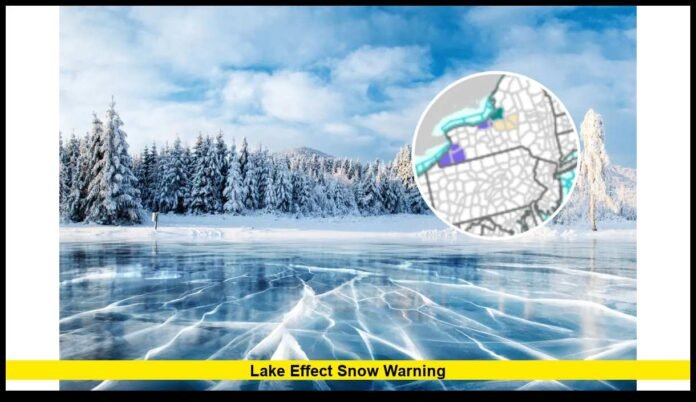A Lake Effect Snow Warning remains in effect today across parts of the Great Lakes region, with narrow but intense bands of snow impacting travel and visibility. Conditions are changing rapidly as lake-effect systems continue to shift inland and drop heavy accumulations in localized corridors.
Latest Updates
• The warning covers shoreline and down-wind zones adjacent to the Great Lakes where cold air moving across unfrozen lake surfaces has triggered convective snow bands.
• Reports indicate snowfall rates locally exceeding 1–3 inches per hour, with additional accumulations of 4 to 8 inches possible in the most persistent bands.
• Wind gusts are contributing to blowing and drifting snow, reducing visibility and increasing the hazard for driving, especially along elevated roadways and open terrain.
• These lake-effect bands are narrow and can produce dramatic differences in accumulation over short distances: one township may receive heavy snow while the next sees little to none.
What a Lake Effect Snow Warning Means
When the forecast office issues a Lake Effect Snow Warning, it signals that heavy snow from lake-effect processes is either imminent or underway. What distinguishes this type of warning:
- The snow forms when very cold air passes over relatively warm lake water, picks up moisture and lift, and then dumps it down-wind in concentrated bands.
- Because the bands are so narrow and intense, conditions can deteriorate abruptly—roads may be clear one mile, snowbound the next.
- Snowfall rates can exceed standard expectations for general snow events, and visibility can collapse quickly in heavy bands.
- These warnings focus on transportation safety, community preparedness, and rapid onset hazards.
Regions Impacted & Travel Outlook
The highest risk zones are the lee shores (down-wind) of the Great Lakes where the wind fetch aligns with the lake axis. Key impacts:
- Areas along eastern and southern shores of lakes like Lake Erie and Lake Ontario may see the most significant accumulations due to favorable wind alignment.
- Expect engineering delays, especially for commuting and shipping operations along lakeshore highways.
- Visibility may drop to a few hundred feet in heavy bands, and road surfaces (including bridges/overpasses) are prone to slick or snow-covered conditions.
- Local agencies are advising anyone in a warned corridor to reduce travel or delay departures until after the snowfall bands pass.
Meteorological Setup
Several key ingredients are aligning for this event:
- A strong wedge of Arctic or Canadian-origin cold air is moving into the Great Lakes region, creating a steep temperature contrast with still-relatively-warm lake waters.
- That contrast fuels instability, allowing moisture to be drawn from the lake surface, lifted, condensed, and deposited as snow in down-wind bands.
- Wind direction is critical: when it runs parallel to the long axis of a lake and out onto land, it drives intense snow inland rather than dispersing it.
- Because lakes remain unfrozen or only partially frozen, they continue to act as heat and moisture sources—keeping the banding mechanism alive.
Warnings, Preparations & Safety Tips
If you reside or travel through a region under a Lake Effect Snow Warning, consider these precautions:
- Delay non-essential travel until conditions improve or the warning is lifted.
- If you must travel, ensure your vehicle is equipped with winter supplies (blanket, shovel, flashlight, food/water, phone charger).
- Monitor road conditions and avoid bridges/overpasses if snow is blowing—these tend to accumulate snow or ice first.
- Stay updated through local road-condition services, state DOT alerts, and the forecast office for updates on band shifting.
- Be aware of micro-scale variability: even if your location appears clear now, a band can drift over you rapidly.
- If you’re outdoors or on the water (for near-shore marine zones), understand that intense bands can generate very low visibility, slick surfaces, and hazardous wind-driven snow showers.
Outlook Going Forward
While some of the most intense snow bands may diminish as the temperature difference between lake and air lessens or the wind flow shifts, the warning remains valid because:
- Bands can redevelop quickly in favorable fetch zones along different lakeshores.
- Additional accumulations of several inches are still possible in favored corridors.
- Wind-driven snow and drifting may continue to degrade travel even if active snowfall slows.
- After the warning, residual snow and drifting may persist, meaning travel remains hazardous until full clearing occurs.
Conclusion
The current Lake Effect Snow Warning highlights how powerful, localized, and sudden lake-effect systems can be. If you are in or planning to travel through a warned zone, stay alert, stay tuned to the latest forecast updates, and adjust your plans accordingly.
Thanks for reading—feel free to comment below if you’d like an update on a specific lake-shore area or travel route!
